Project Charter for Online Stud Farm Management System (OSFMS) - 2018
VerifiedAdded on 2021/05/31
|18
|2373
|465
Project
AI Summary
This project charter outlines the development of an Online Stud Farm Management System (OSFMS), detailing the Measurable Organizational Value (MOV), scope management plan, project schedule with a Work Breakdown Structure (WBS) and Gantt chart, time-phased budget, risk analysis and mitigation strategies, and a comprehensive quality plan. The MOV focuses on improving booking efficiency, reducing costs, and increasing revenues. The scope encompasses various activities from information gathering to system implementation, while excluding marketing and advertising. Risk assessment includes identification, evaluation, and treatment of potential issues. The quality plan emphasizes verification and validation activities to ensure a defect-free product, with closure and evaluation guidelines to measure project success against the initial objectives. The document also includes references and an annotated bibliography.
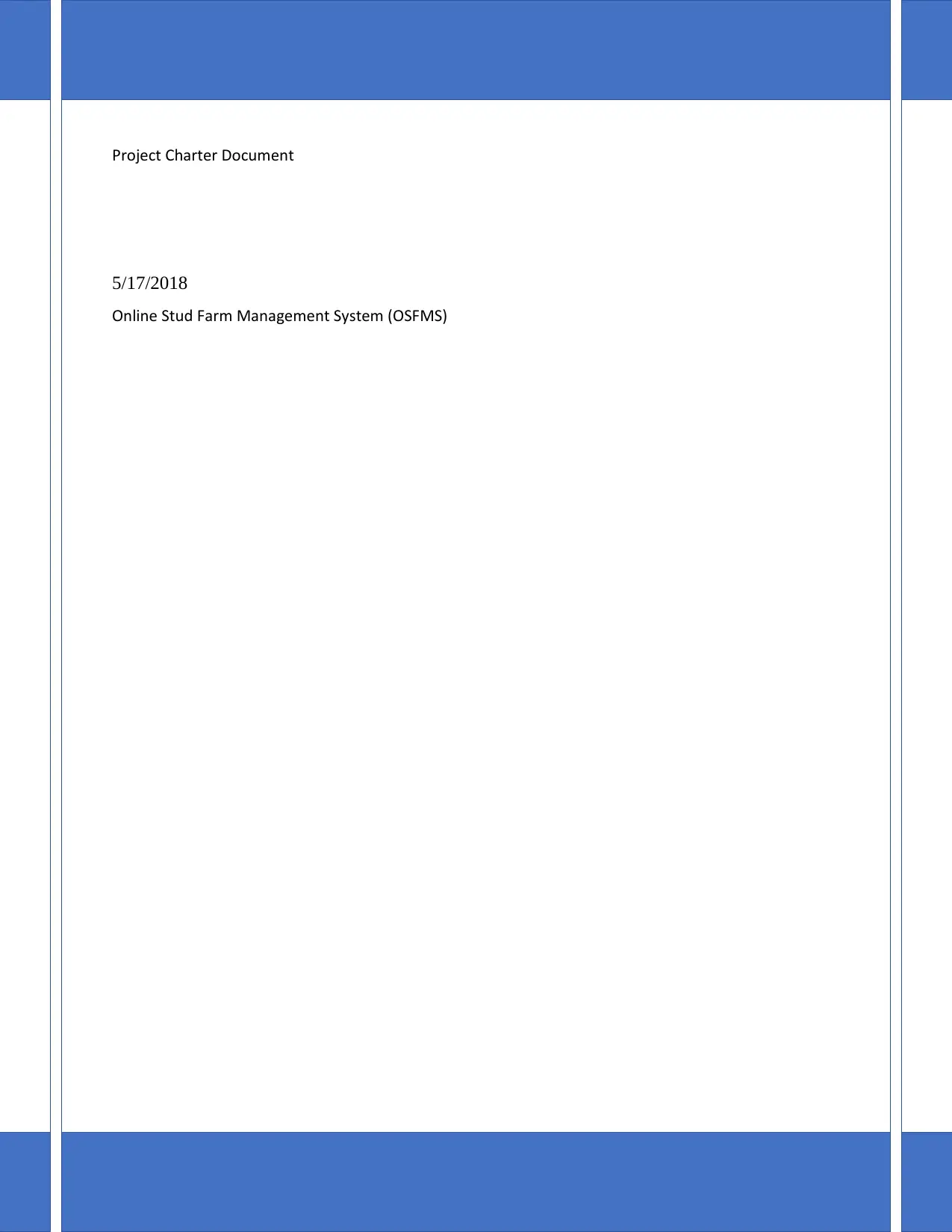
Project Charter Document
5/17/2018
Online Stud Farm Management System (OSFMS)
5/17/2018
Online Stud Farm Management System (OSFMS)
Paraphrase This Document
Need a fresh take? Get an instant paraphrase of this document with our AI Paraphraser
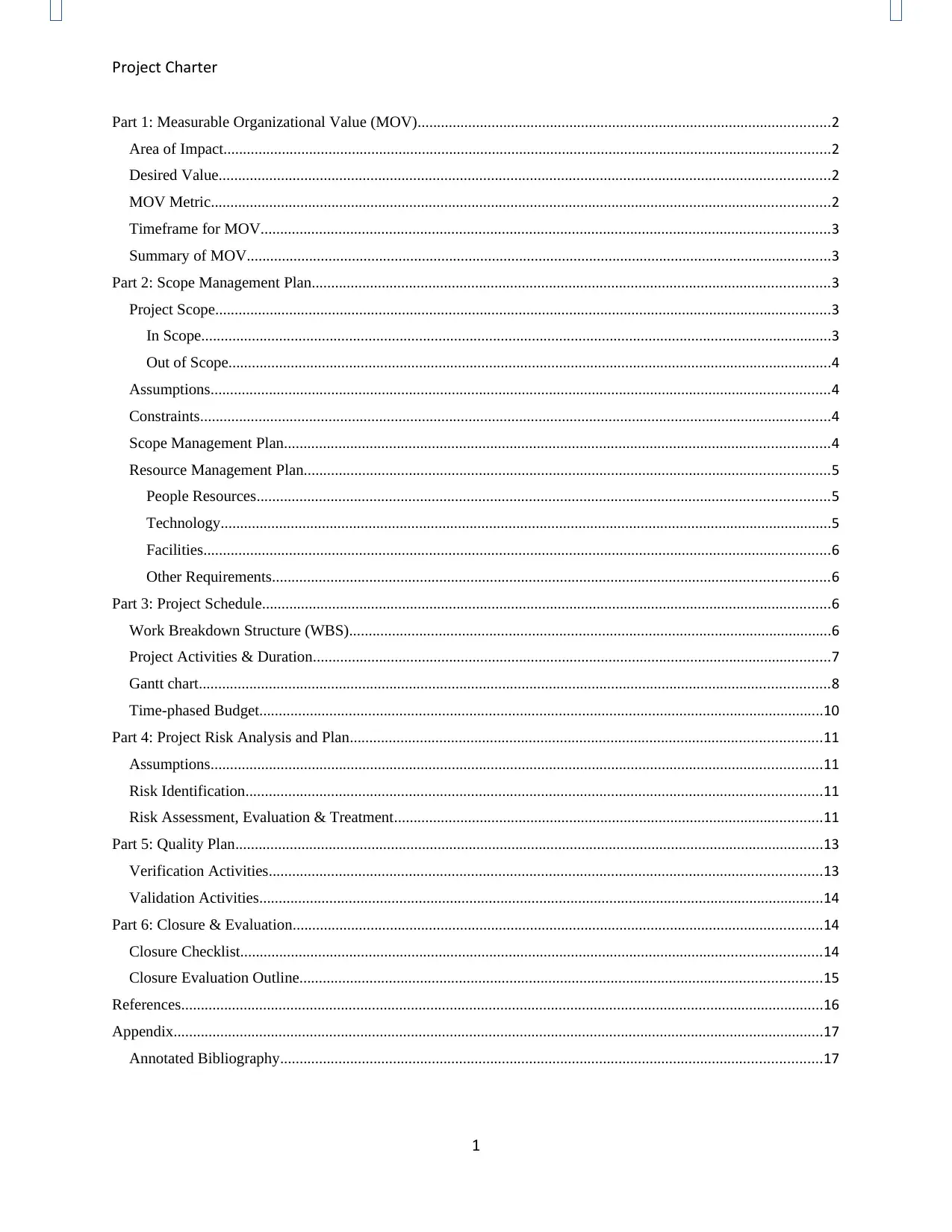
Project Charter
Part 1: Measurable Organizational Value (MOV)..........................................................................................................2
Area of Impact............................................................................................................................................................2
Desired Value.............................................................................................................................................................2
MOV Metric...............................................................................................................................................................2
Timeframe for MOV..................................................................................................................................................3
Summary of MOV......................................................................................................................................................3
Part 2: Scope Management Plan.....................................................................................................................................3
Project Scope..............................................................................................................................................................3
In Scope..................................................................................................................................................................3
Out of Scope...........................................................................................................................................................4
Assumptions...............................................................................................................................................................4
Constraints..................................................................................................................................................................4
Scope Management Plan............................................................................................................................................4
Resource Management Plan.......................................................................................................................................5
People Resources...................................................................................................................................................5
Technology.............................................................................................................................................................5
Facilities.................................................................................................................................................................6
Other Requirements...............................................................................................................................................6
Part 3: Project Schedule..................................................................................................................................................6
Work Breakdown Structure (WBS)............................................................................................................................6
Project Activities & Duration.....................................................................................................................................7
Gantt chart..................................................................................................................................................................8
Time-phased Budget.................................................................................................................................................10
Part 4: Project Risk Analysis and Plan.........................................................................................................................11
Assumptions.............................................................................................................................................................11
Risk Identification....................................................................................................................................................11
Risk Assessment, Evaluation & Treatment..............................................................................................................11
Part 5: Quality Plan.......................................................................................................................................................13
Verification Activities..............................................................................................................................................13
Validation Activities.................................................................................................................................................14
Part 6: Closure & Evaluation........................................................................................................................................14
Closure Checklist.....................................................................................................................................................14
Closure Evaluation Outline......................................................................................................................................15
References.....................................................................................................................................................................16
Appendix.......................................................................................................................................................................17
Annotated Bibliography...........................................................................................................................................17
1
Part 1: Measurable Organizational Value (MOV)..........................................................................................................2
Area of Impact............................................................................................................................................................2
Desired Value.............................................................................................................................................................2
MOV Metric...............................................................................................................................................................2
Timeframe for MOV..................................................................................................................................................3
Summary of MOV......................................................................................................................................................3
Part 2: Scope Management Plan.....................................................................................................................................3
Project Scope..............................................................................................................................................................3
In Scope..................................................................................................................................................................3
Out of Scope...........................................................................................................................................................4
Assumptions...............................................................................................................................................................4
Constraints..................................................................................................................................................................4
Scope Management Plan............................................................................................................................................4
Resource Management Plan.......................................................................................................................................5
People Resources...................................................................................................................................................5
Technology.............................................................................................................................................................5
Facilities.................................................................................................................................................................6
Other Requirements...............................................................................................................................................6
Part 3: Project Schedule..................................................................................................................................................6
Work Breakdown Structure (WBS)............................................................................................................................6
Project Activities & Duration.....................................................................................................................................7
Gantt chart..................................................................................................................................................................8
Time-phased Budget.................................................................................................................................................10
Part 4: Project Risk Analysis and Plan.........................................................................................................................11
Assumptions.............................................................................................................................................................11
Risk Identification....................................................................................................................................................11
Risk Assessment, Evaluation & Treatment..............................................................................................................11
Part 5: Quality Plan.......................................................................................................................................................13
Verification Activities..............................................................................................................................................13
Validation Activities.................................................................................................................................................14
Part 6: Closure & Evaluation........................................................................................................................................14
Closure Checklist.....................................................................................................................................................14
Closure Evaluation Outline......................................................................................................................................15
References.....................................................................................................................................................................16
Appendix.......................................................................................................................................................................17
Annotated Bibliography...........................................................................................................................................17
1
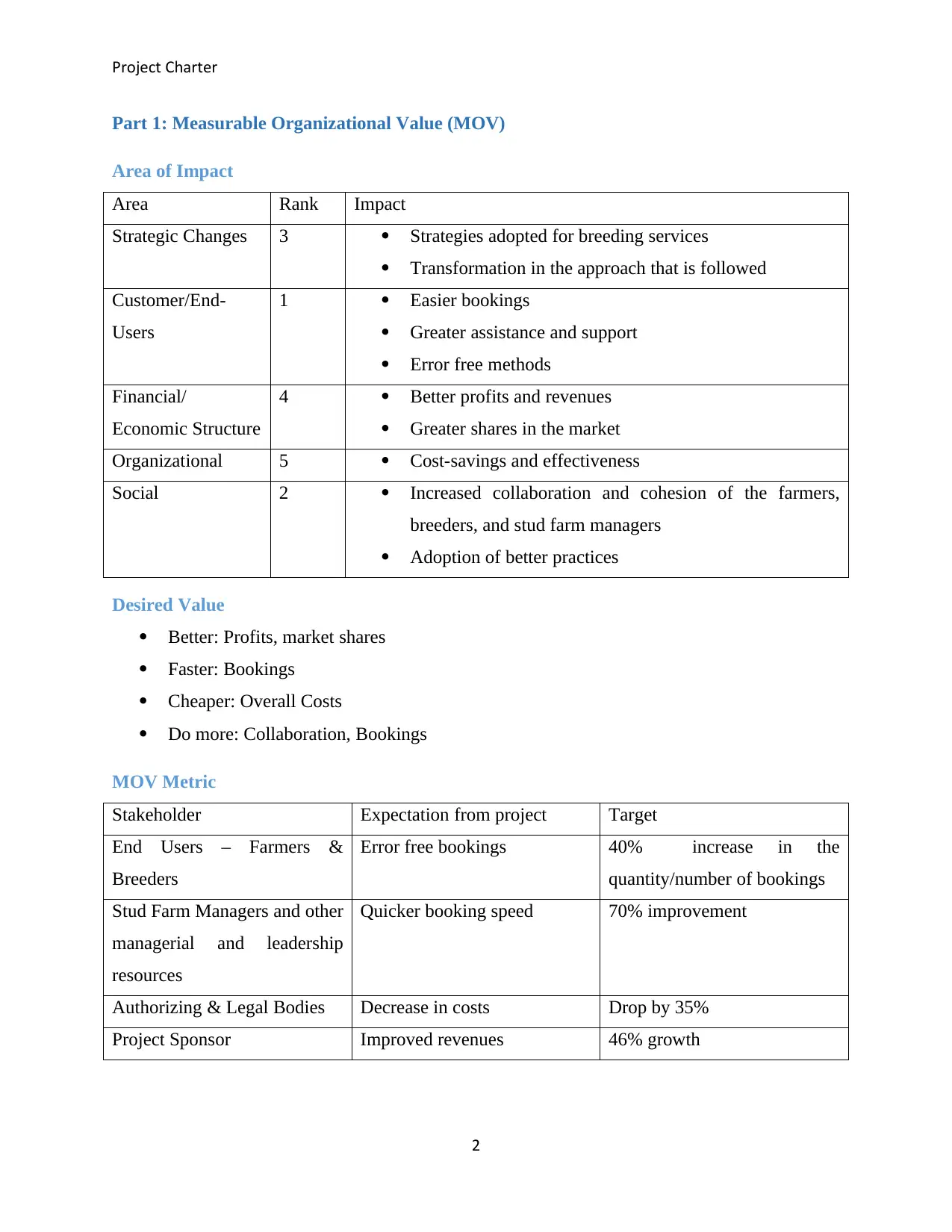
Project Charter
Part 1: Measurable Organizational Value (MOV)
Area of Impact
Area Rank Impact
Strategic Changes 3 Strategies adopted for breeding services
Transformation in the approach that is followed
Customer/End-
Users
1 Easier bookings
Greater assistance and support
Error free methods
Financial/
Economic Structure
4 Better profits and revenues
Greater shares in the market
Organizational 5 Cost-savings and effectiveness
Social 2 Increased collaboration and cohesion of the farmers,
breeders, and stud farm managers
Adoption of better practices
Desired Value
Better: Profits, market shares
Faster: Bookings
Cheaper: Overall Costs
Do more: Collaboration, Bookings
MOV Metric
Stakeholder Expectation from project Target
End Users – Farmers &
Breeders
Error free bookings 40% increase in the
quantity/number of bookings
Stud Farm Managers and other
managerial and leadership
resources
Quicker booking speed 70% improvement
Authorizing & Legal Bodies Decrease in costs Drop by 35%
Project Sponsor Improved revenues 46% growth
2
Part 1: Measurable Organizational Value (MOV)
Area of Impact
Area Rank Impact
Strategic Changes 3 Strategies adopted for breeding services
Transformation in the approach that is followed
Customer/End-
Users
1 Easier bookings
Greater assistance and support
Error free methods
Financial/
Economic Structure
4 Better profits and revenues
Greater shares in the market
Organizational 5 Cost-savings and effectiveness
Social 2 Increased collaboration and cohesion of the farmers,
breeders, and stud farm managers
Adoption of better practices
Desired Value
Better: Profits, market shares
Faster: Bookings
Cheaper: Overall Costs
Do more: Collaboration, Bookings
MOV Metric
Stakeholder Expectation from project Target
End Users – Farmers &
Breeders
Error free bookings 40% increase in the
quantity/number of bookings
Stud Farm Managers and other
managerial and leadership
resources
Quicker booking speed 70% improvement
Authorizing & Legal Bodies Decrease in costs Drop by 35%
Project Sponsor Improved revenues 46% growth
2
⊘ This is a preview!⊘
Do you want full access?
Subscribe today to unlock all pages.

Trusted by 1+ million students worldwide
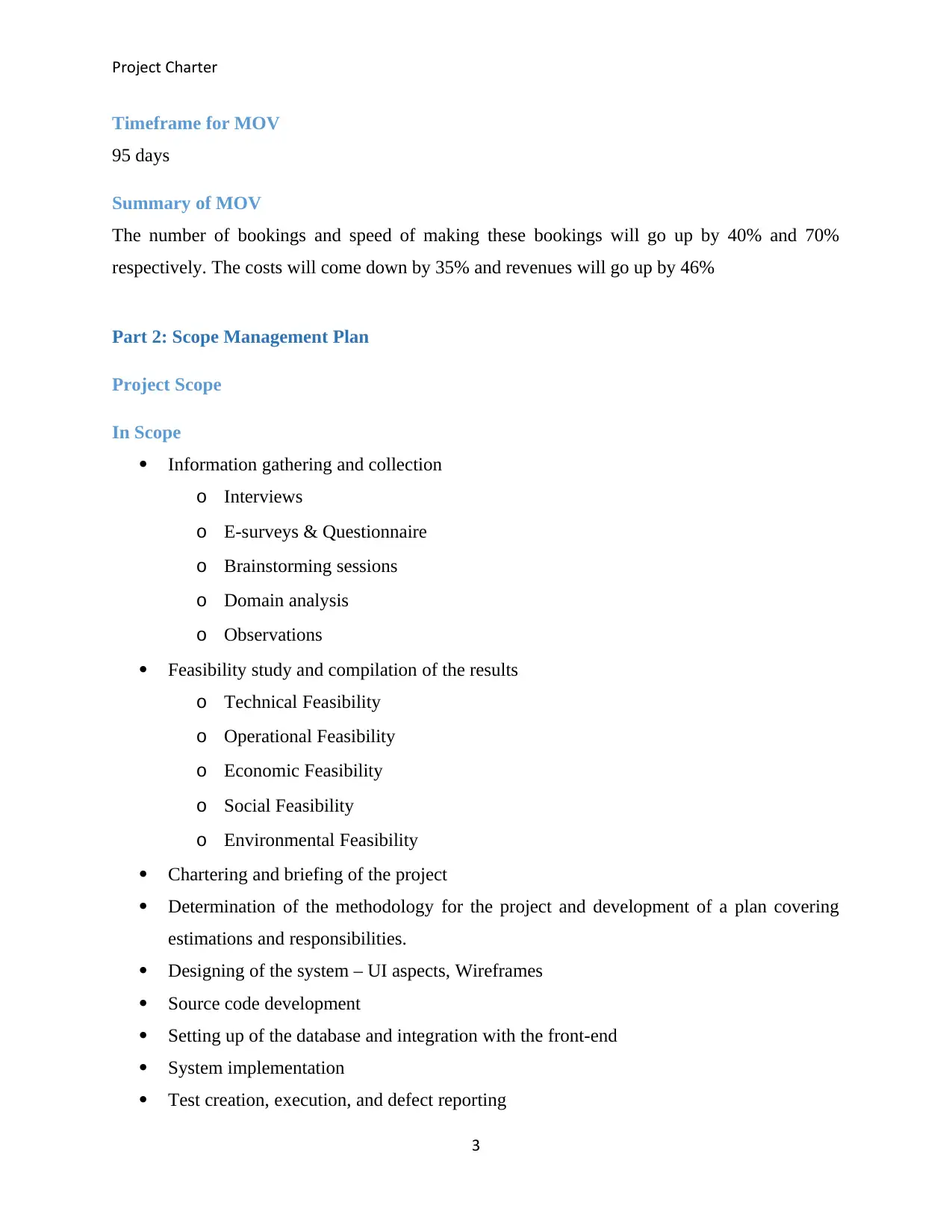
Project Charter
Timeframe for MOV
95 days
Summary of MOV
The number of bookings and speed of making these bookings will go up by 40% and 70%
respectively. The costs will come down by 35% and revenues will go up by 46%
Part 2: Scope Management Plan
Project Scope
In Scope
Information gathering and collection
o Interviews
o E-surveys & Questionnaire
o Brainstorming sessions
o Domain analysis
o Observations
Feasibility study and compilation of the results
o Technical Feasibility
o Operational Feasibility
o Economic Feasibility
o Social Feasibility
o Environmental Feasibility
Chartering and briefing of the project
Determination of the methodology for the project and development of a plan covering
estimations and responsibilities.
Designing of the system – UI aspects, Wireframes
Source code development
Setting up of the database and integration with the front-end
System implementation
Test creation, execution, and defect reporting
3
Timeframe for MOV
95 days
Summary of MOV
The number of bookings and speed of making these bookings will go up by 40% and 70%
respectively. The costs will come down by 35% and revenues will go up by 46%
Part 2: Scope Management Plan
Project Scope
In Scope
Information gathering and collection
o Interviews
o E-surveys & Questionnaire
o Brainstorming sessions
o Domain analysis
o Observations
Feasibility study and compilation of the results
o Technical Feasibility
o Operational Feasibility
o Economic Feasibility
o Social Feasibility
o Environmental Feasibility
Chartering and briefing of the project
Determination of the methodology for the project and development of a plan covering
estimations and responsibilities.
Designing of the system – UI aspects, Wireframes
Source code development
Setting up of the database and integration with the front-end
System implementation
Test creation, execution, and defect reporting
3
Paraphrase This Document
Need a fresh take? Get an instant paraphrase of this document with our AI Paraphraser
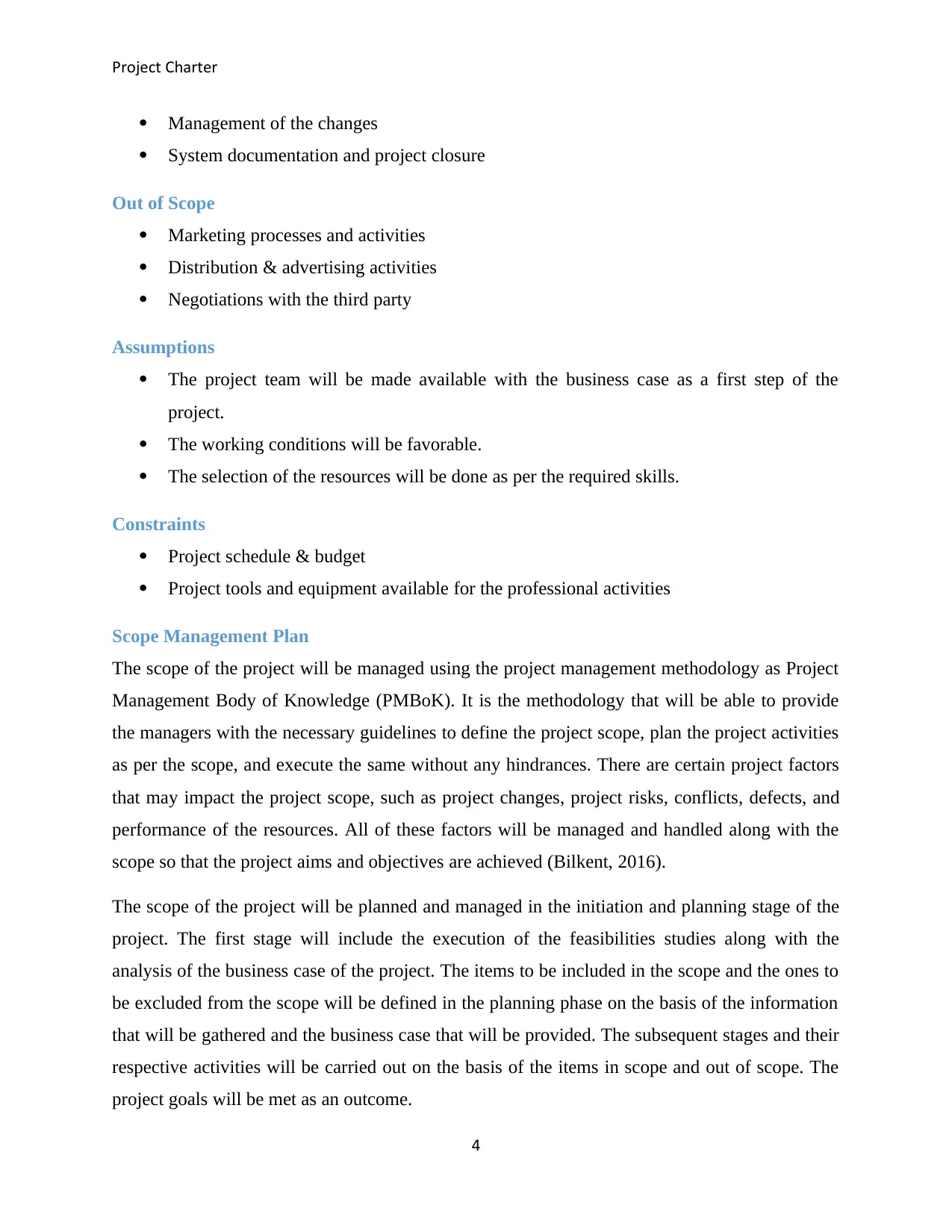
Project Charter
Management of the changes
System documentation and project closure
Out of Scope
Marketing processes and activities
Distribution & advertising activities
Negotiations with the third party
Assumptions
The project team will be made available with the business case as a first step of the
project.
The working conditions will be favorable.
The selection of the resources will be done as per the required skills.
Constraints
Project schedule & budget
Project tools and equipment available for the professional activities
Scope Management Plan
The scope of the project will be managed using the project management methodology as Project
Management Body of Knowledge (PMBoK). It is the methodology that will be able to provide
the managers with the necessary guidelines to define the project scope, plan the project activities
as per the scope, and execute the same without any hindrances. There are certain project factors
that may impact the project scope, such as project changes, project risks, conflicts, defects, and
performance of the resources. All of these factors will be managed and handled along with the
scope so that the project aims and objectives are achieved (Bilkent, 2016).
The scope of the project will be planned and managed in the initiation and planning stage of the
project. The first stage will include the execution of the feasibilities studies along with the
analysis of the business case of the project. The items to be included in the scope and the ones to
be excluded from the scope will be defined in the planning phase on the basis of the information
that will be gathered and the business case that will be provided. The subsequent stages and their
respective activities will be carried out on the basis of the items in scope and out of scope. The
project goals will be met as an outcome.
4
Management of the changes
System documentation and project closure
Out of Scope
Marketing processes and activities
Distribution & advertising activities
Negotiations with the third party
Assumptions
The project team will be made available with the business case as a first step of the
project.
The working conditions will be favorable.
The selection of the resources will be done as per the required skills.
Constraints
Project schedule & budget
Project tools and equipment available for the professional activities
Scope Management Plan
The scope of the project will be managed using the project management methodology as Project
Management Body of Knowledge (PMBoK). It is the methodology that will be able to provide
the managers with the necessary guidelines to define the project scope, plan the project activities
as per the scope, and execute the same without any hindrances. There are certain project factors
that may impact the project scope, such as project changes, project risks, conflicts, defects, and
performance of the resources. All of these factors will be managed and handled along with the
scope so that the project aims and objectives are achieved (Bilkent, 2016).
The scope of the project will be planned and managed in the initiation and planning stage of the
project. The first stage will include the execution of the feasibilities studies along with the
analysis of the business case of the project. The items to be included in the scope and the ones to
be excluded from the scope will be defined in the planning phase on the basis of the information
that will be gathered and the business case that will be provided. The subsequent stages and their
respective activities will be carried out on the basis of the items in scope and out of scope. The
project goals will be met as an outcome.
4
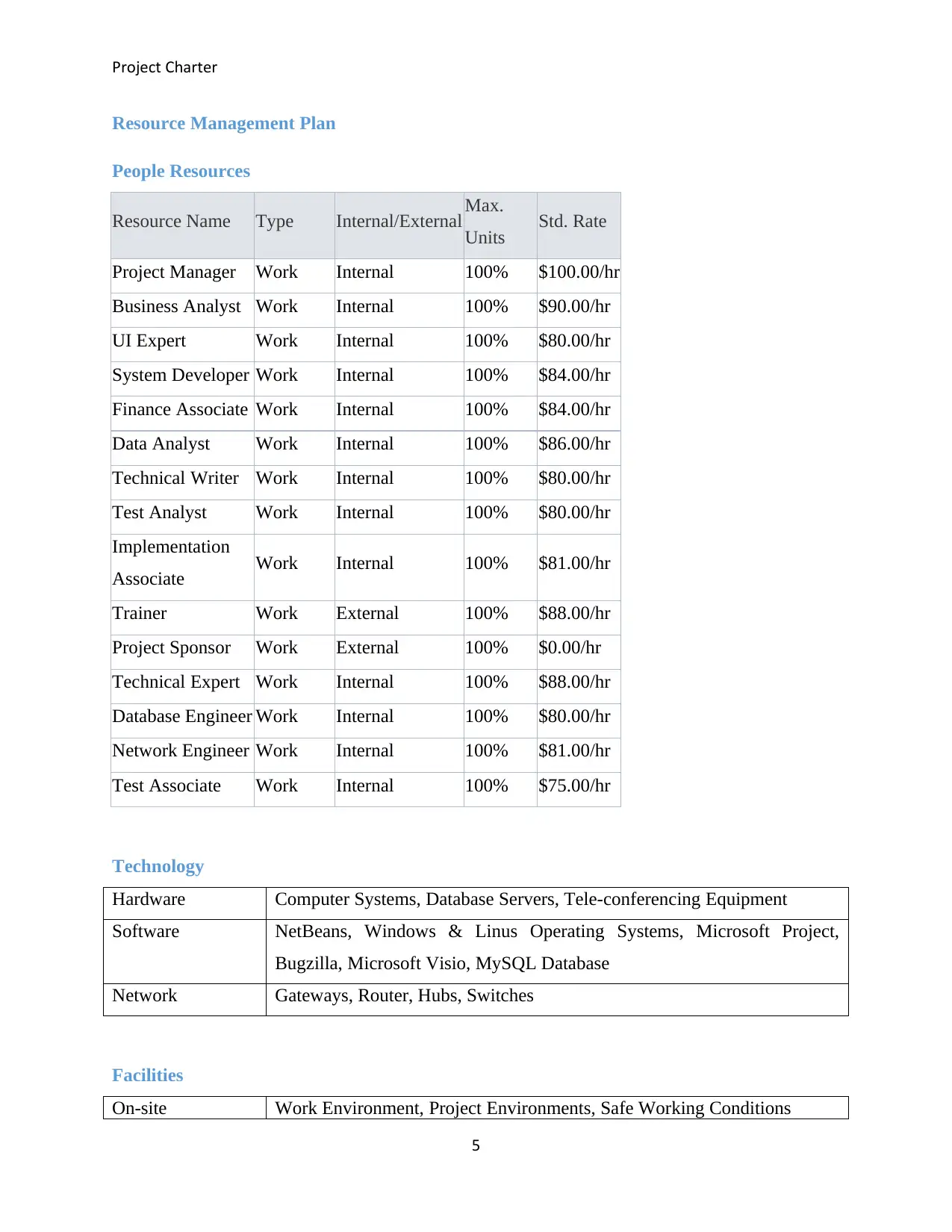
Project Charter
Resource Management Plan
People Resources
Resource Name Type Internal/External Max.
Units Std. Rate
Project Manager Work Internal 100% $100.00/hr
Business Analyst Work Internal 100% $90.00/hr
UI Expert Work Internal 100% $80.00/hr
System Developer Work Internal 100% $84.00/hr
Finance Associate Work Internal 100% $84.00/hr
Data Analyst Work Internal 100% $86.00/hr
Technical Writer Work Internal 100% $80.00/hr
Test Analyst Work Internal 100% $80.00/hr
Implementation
Associate Work Internal 100% $81.00/hr
Trainer Work External 100% $88.00/hr
Project Sponsor Work External 100% $0.00/hr
Technical Expert Work Internal 100% $88.00/hr
Database Engineer Work Internal 100% $80.00/hr
Network Engineer Work Internal 100% $81.00/hr
Test Associate Work Internal 100% $75.00/hr
Technology
Hardware Computer Systems, Database Servers, Tele-conferencing Equipment
Software NetBeans, Windows & Linus Operating Systems, Microsoft Project,
Bugzilla, Microsoft Visio, MySQL Database
Network Gateways, Router, Hubs, Switches
Facilities
On-site Work Environment, Project Environments, Safe Working Conditions
5
Resource Management Plan
People Resources
Resource Name Type Internal/External Max.
Units Std. Rate
Project Manager Work Internal 100% $100.00/hr
Business Analyst Work Internal 100% $90.00/hr
UI Expert Work Internal 100% $80.00/hr
System Developer Work Internal 100% $84.00/hr
Finance Associate Work Internal 100% $84.00/hr
Data Analyst Work Internal 100% $86.00/hr
Technical Writer Work Internal 100% $80.00/hr
Test Analyst Work Internal 100% $80.00/hr
Implementation
Associate Work Internal 100% $81.00/hr
Trainer Work External 100% $88.00/hr
Project Sponsor Work External 100% $0.00/hr
Technical Expert Work Internal 100% $88.00/hr
Database Engineer Work Internal 100% $80.00/hr
Network Engineer Work Internal 100% $81.00/hr
Test Associate Work Internal 100% $75.00/hr
Technology
Hardware Computer Systems, Database Servers, Tele-conferencing Equipment
Software NetBeans, Windows & Linus Operating Systems, Microsoft Project,
Bugzilla, Microsoft Visio, MySQL Database
Network Gateways, Router, Hubs, Switches
Facilities
On-site Work Environment, Project Environments, Safe Working Conditions
5
⊘ This is a preview!⊘
Do you want full access?
Subscribe today to unlock all pages.

Trusted by 1+ million students worldwide
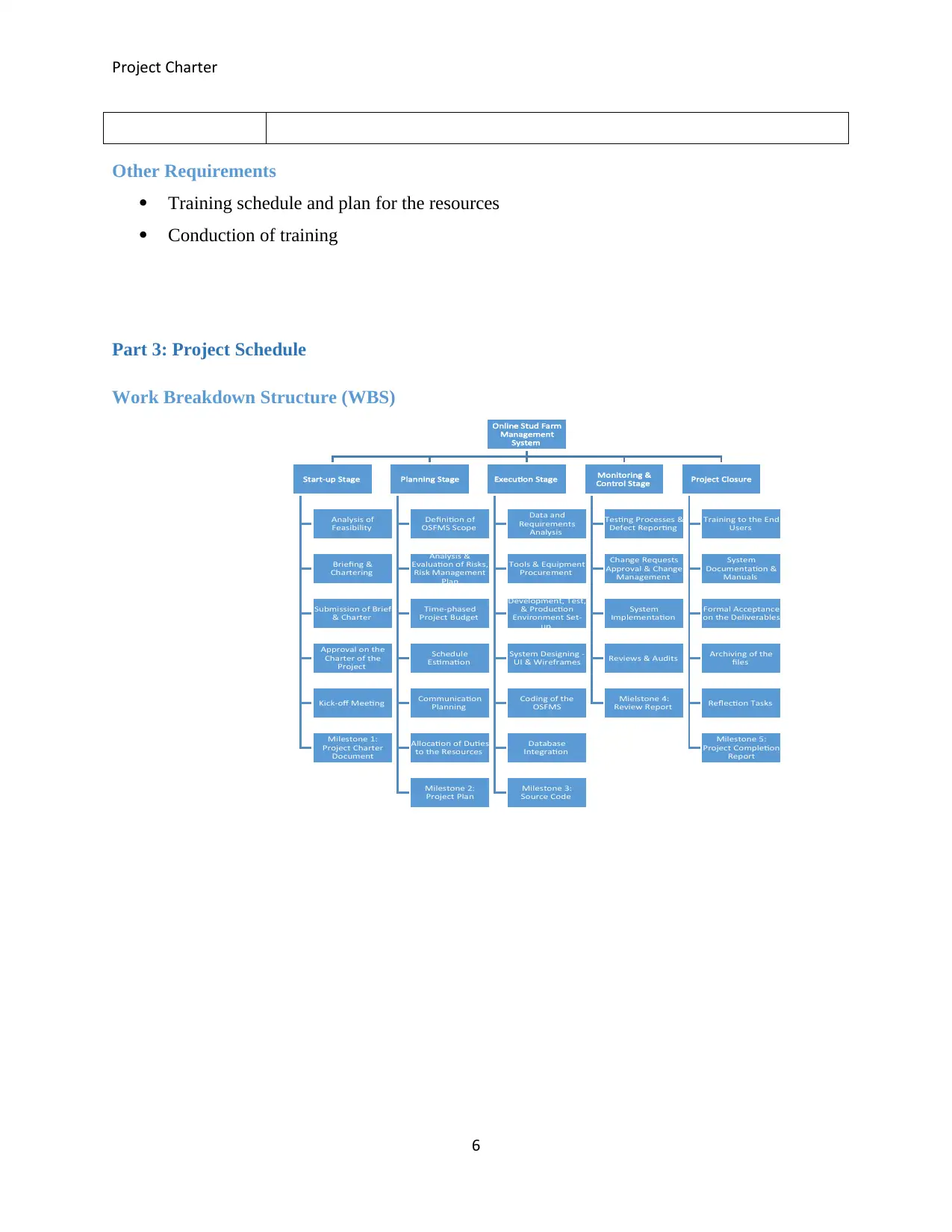
Project Charter
Other Requirements
Training schedule and plan for the resources
Conduction of training
Part 3: Project Schedule
Work Breakdown Structure (WBS)
6
Online Stud Farm
Management
System
Start-up Stage
Analysis of
Feasibility
Briefing &
Chartering
Submission of Brief
& Charter
Approval on the
Charter of the
Project
Kick-off Meeting
Milestone 1:
Project Charter
Document
Planning Stage
Definition of
OSFMS Scope
Analysis &
Evaluation of Risks,
Risk Management
Plan
Time-phased
Project Budget
Schedule
Estimation
Communication
Planning
Allocation of Duties
to the Resources
Milestone 2:
Project Plan
Execution Stage
Data and
Requirements
Analysis
Tools & Equipment
Procurement
Development, Test,
& Production
Environment Set-
up
System Designing -
UI & Wireframes
Coding of the
OSFMS
Database
Integration
Milestone 3:
Source Code
Monitoring &
Control Stage
Testing Processes &
Defect Reporting
Change Requests
Approval & Change
Management
System
Implementation
Reviews & Audits
Mielstone 4:
Review Report
Project Closure
Training to the End
Users
System
Documentation &
Manuals
Formal Acceptance
on the Deliverables
Archiving of the
files
Reflection Tasks
Milestone 5:
Project Completion
Report
Other Requirements
Training schedule and plan for the resources
Conduction of training
Part 3: Project Schedule
Work Breakdown Structure (WBS)
6
Online Stud Farm
Management
System
Start-up Stage
Analysis of
Feasibility
Briefing &
Chartering
Submission of Brief
& Charter
Approval on the
Charter of the
Project
Kick-off Meeting
Milestone 1:
Project Charter
Document
Planning Stage
Definition of
OSFMS Scope
Analysis &
Evaluation of Risks,
Risk Management
Plan
Time-phased
Project Budget
Schedule
Estimation
Communication
Planning
Allocation of Duties
to the Resources
Milestone 2:
Project Plan
Execution Stage
Data and
Requirements
Analysis
Tools & Equipment
Procurement
Development, Test,
& Production
Environment Set-
up
System Designing -
UI & Wireframes
Coding of the
OSFMS
Database
Integration
Milestone 3:
Source Code
Monitoring &
Control Stage
Testing Processes &
Defect Reporting
Change Requests
Approval & Change
Management
System
Implementation
Reviews & Audits
Mielstone 4:
Review Report
Project Closure
Training to the End
Users
System
Documentation &
Manuals
Formal Acceptance
on the Deliverables
Archiving of the
files
Reflection Tasks
Milestone 5:
Project Completion
Report
Paraphrase This Document
Need a fresh take? Get an instant paraphrase of this document with our AI Paraphraser
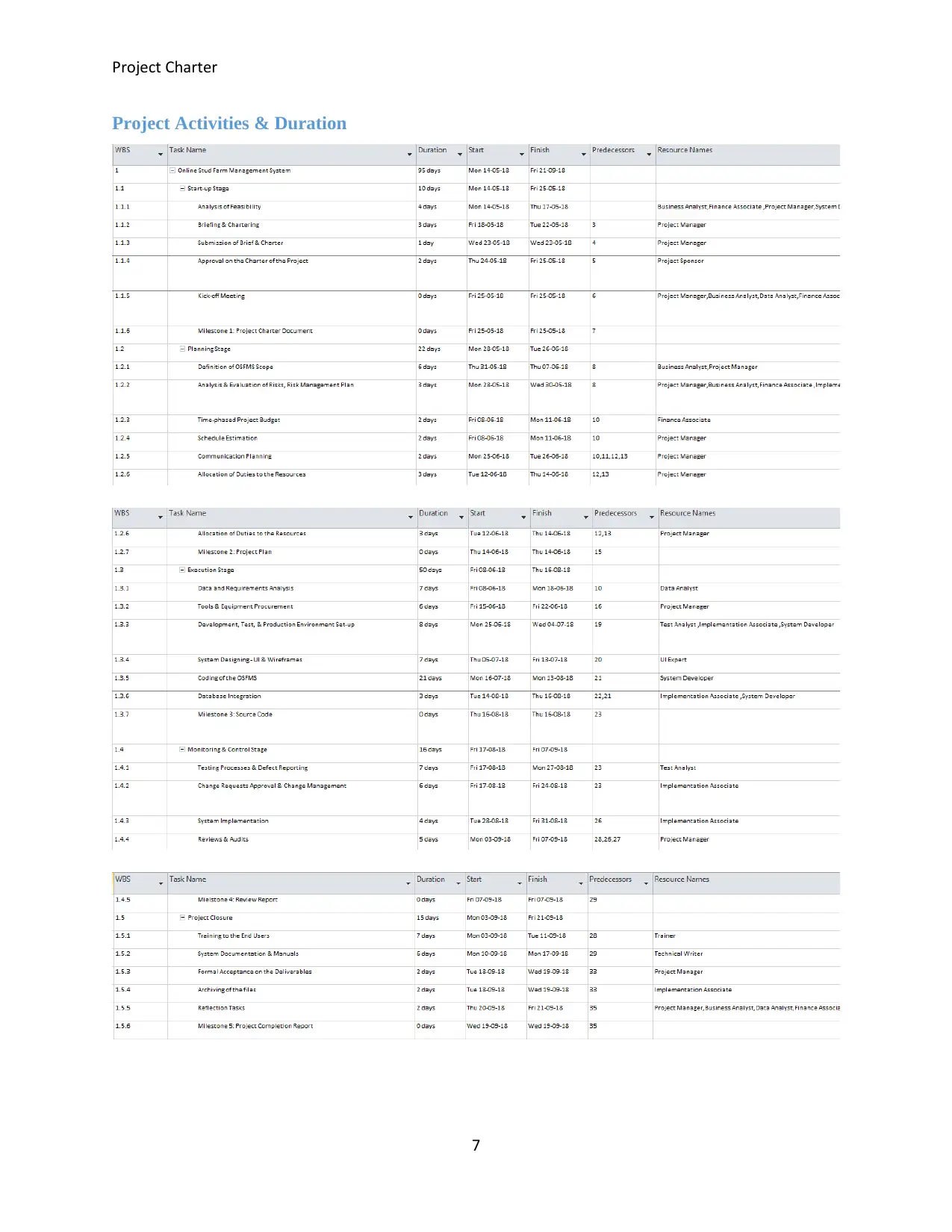
Project Charter
Project Activities & Duration
7
Project Activities & Duration
7
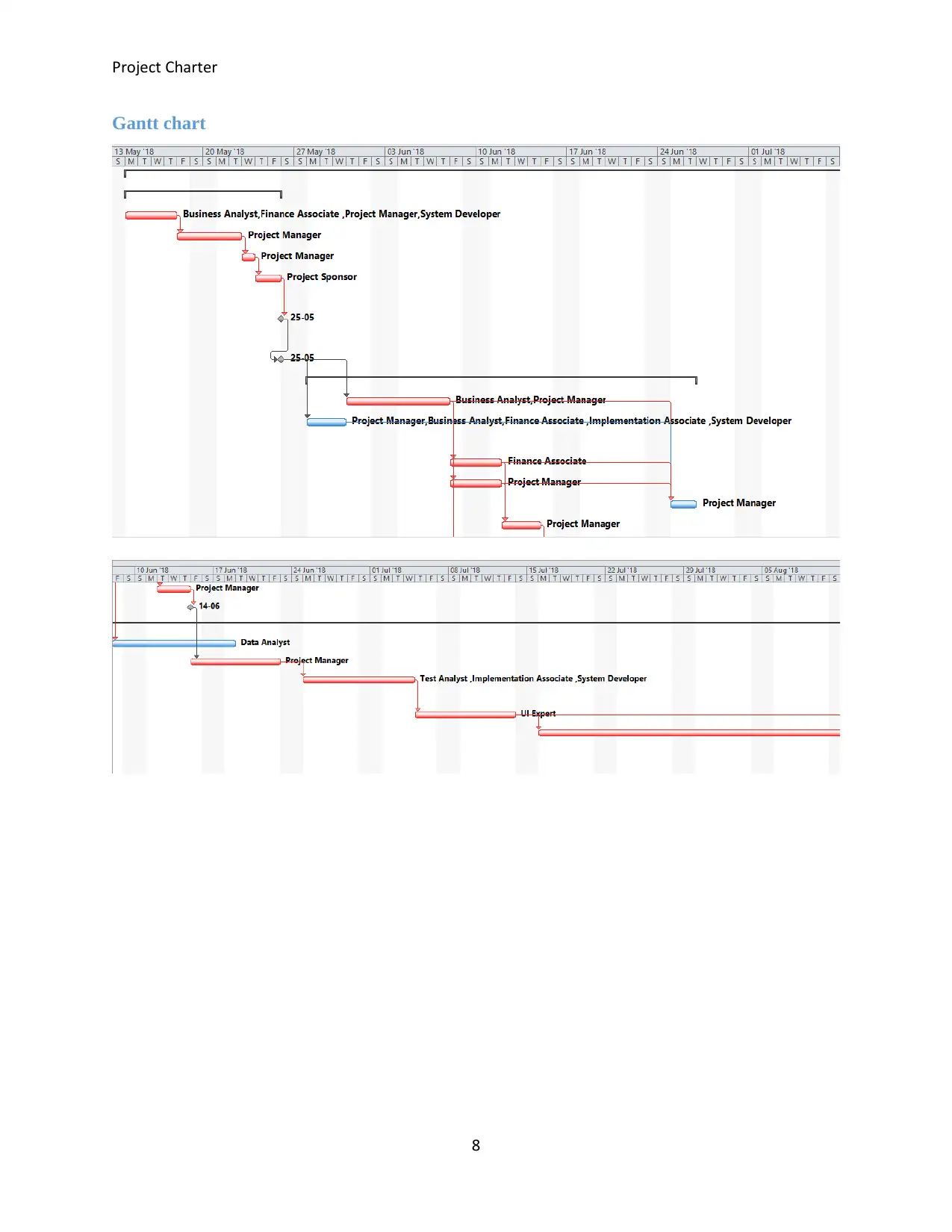
Project Charter
Gantt chart
8
Gantt chart
8
⊘ This is a preview!⊘
Do you want full access?
Subscribe today to unlock all pages.

Trusted by 1+ million students worldwide
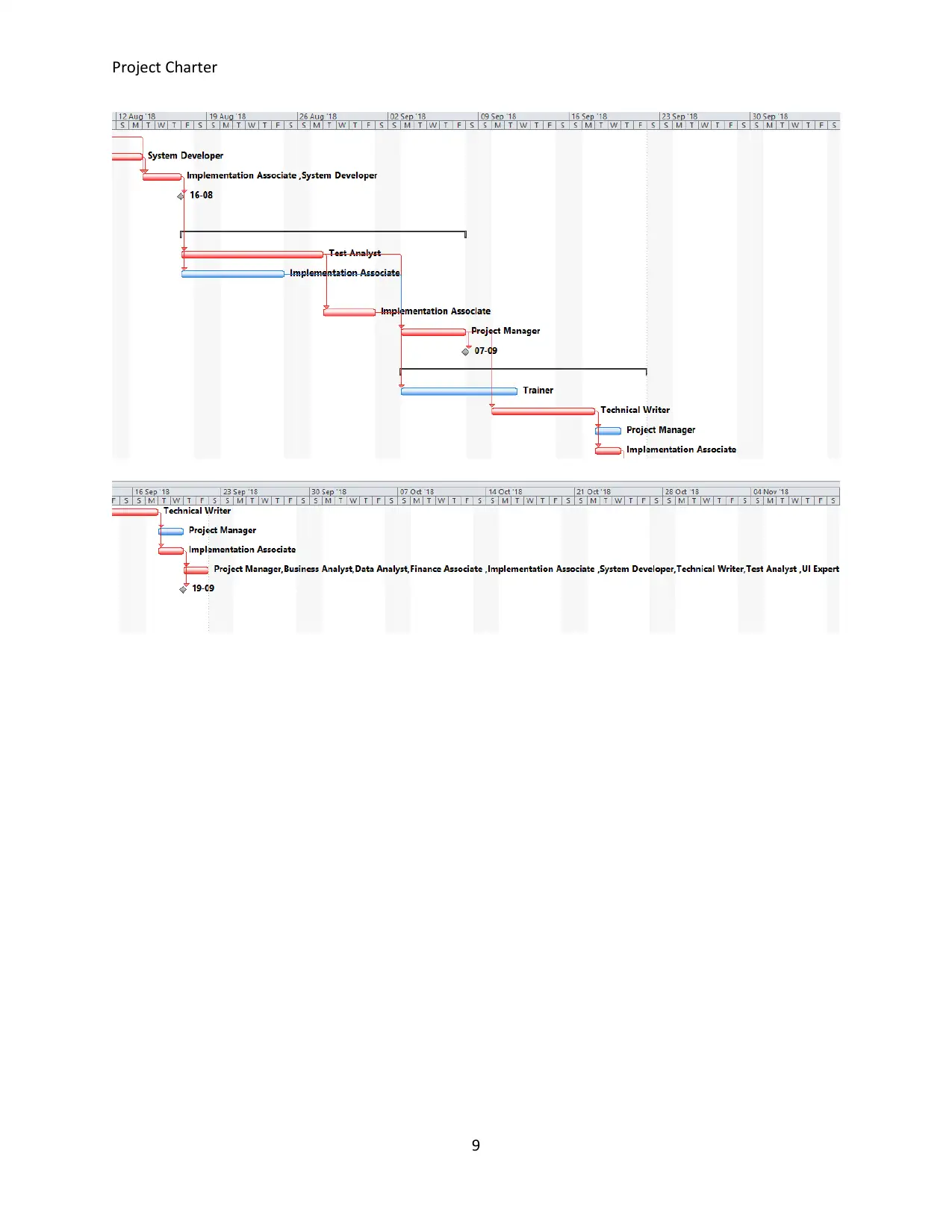
Project Charter
9
9
Paraphrase This Document
Need a fresh take? Get an instant paraphrase of this document with our AI Paraphraser
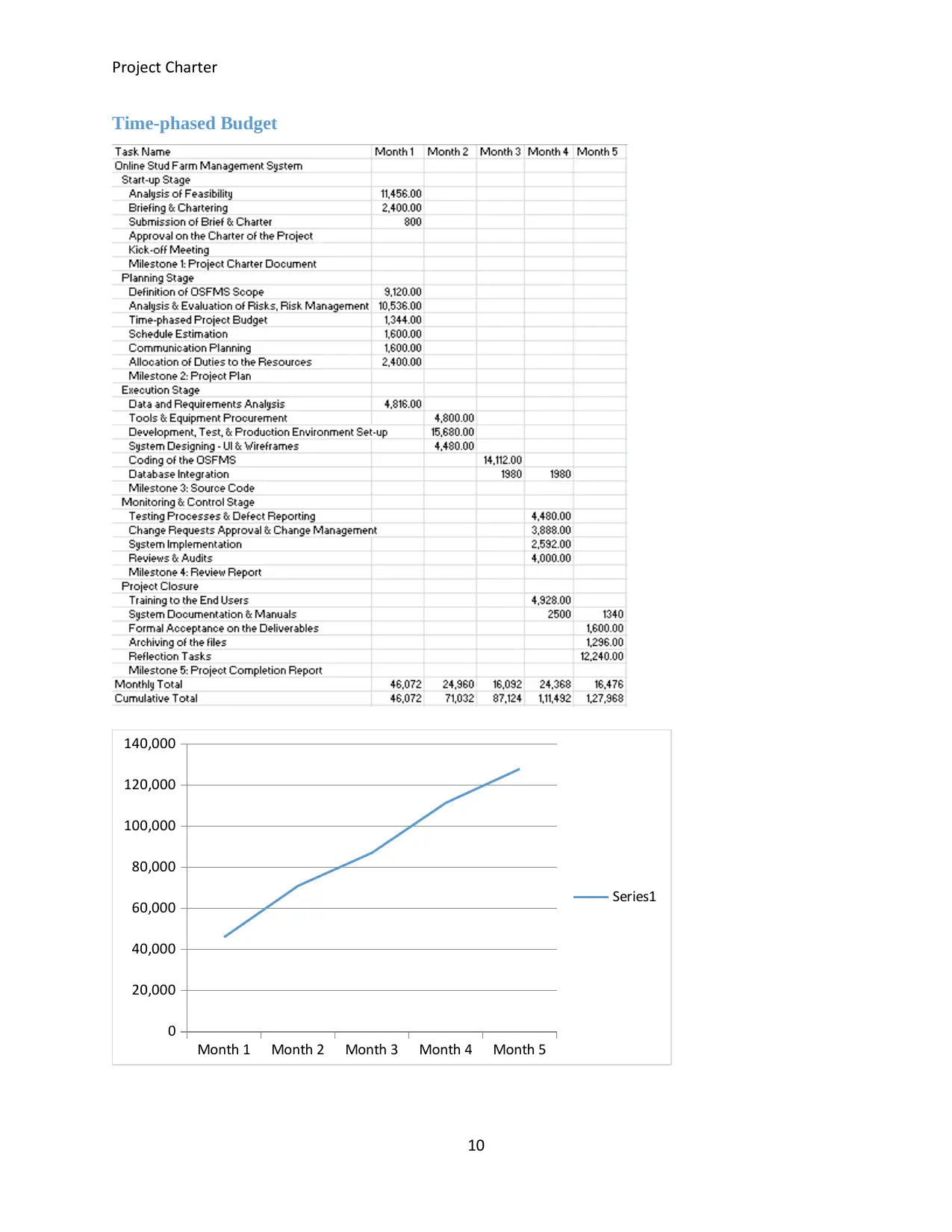
Project Charter
Time-phased Budget
Month 1 Month 2 Month 3 Month 4 Month 5
0
20,000
40,000
60,000
80,000
100,000
120,000
140,000
Series1
10
Time-phased Budget
Month 1 Month 2 Month 3 Month 4 Month 5
0
20,000
40,000
60,000
80,000
100,000
120,000
140,000
Series1
10
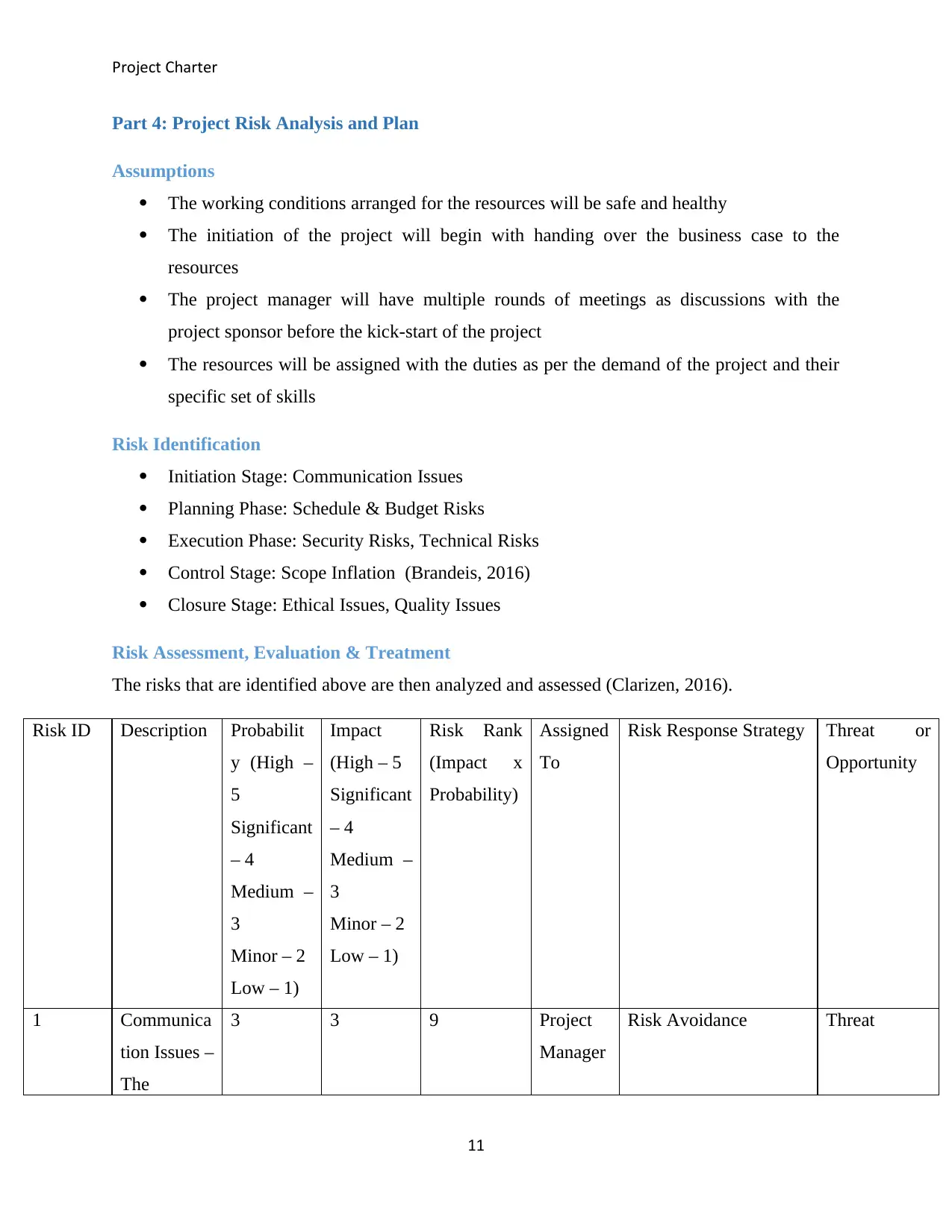
Project Charter
Part 4: Project Risk Analysis and Plan
Assumptions
The working conditions arranged for the resources will be safe and healthy
The initiation of the project will begin with handing over the business case to the
resources
The project manager will have multiple rounds of meetings as discussions with the
project sponsor before the kick-start of the project
The resources will be assigned with the duties as per the demand of the project and their
specific set of skills
Risk Identification
Initiation Stage: Communication Issues
Planning Phase: Schedule & Budget Risks
Execution Phase: Security Risks, Technical Risks
Control Stage: Scope Inflation (Brandeis, 2016)
Closure Stage: Ethical Issues, Quality Issues
Risk Assessment, Evaluation & Treatment
The risks that are identified above are then analyzed and assessed (Clarizen, 2016).
Risk ID Description Probabilit
y (High –
5
Significant
– 4
Medium –
3
Minor – 2
Low – 1)
Impact
(High – 5
Significant
– 4
Medium –
3
Minor – 2
Low – 1)
Risk Rank
(Impact x
Probability)
Assigned
To
Risk Response Strategy Threat or
Opportunity
1 Communica
tion Issues –
The
3 3 9 Project
Manager
Risk Avoidance Threat
11
Part 4: Project Risk Analysis and Plan
Assumptions
The working conditions arranged for the resources will be safe and healthy
The initiation of the project will begin with handing over the business case to the
resources
The project manager will have multiple rounds of meetings as discussions with the
project sponsor before the kick-start of the project
The resources will be assigned with the duties as per the demand of the project and their
specific set of skills
Risk Identification
Initiation Stage: Communication Issues
Planning Phase: Schedule & Budget Risks
Execution Phase: Security Risks, Technical Risks
Control Stage: Scope Inflation (Brandeis, 2016)
Closure Stage: Ethical Issues, Quality Issues
Risk Assessment, Evaluation & Treatment
The risks that are identified above are then analyzed and assessed (Clarizen, 2016).
Risk ID Description Probabilit
y (High –
5
Significant
– 4
Medium –
3
Minor – 2
Low – 1)
Impact
(High – 5
Significant
– 4
Medium –
3
Minor – 2
Low – 1)
Risk Rank
(Impact x
Probability)
Assigned
To
Risk Response Strategy Threat or
Opportunity
1 Communica
tion Issues –
The
3 3 9 Project
Manager
Risk Avoidance Threat
11
⊘ This is a preview!⊘
Do you want full access?
Subscribe today to unlock all pages.

Trusted by 1+ million students worldwide
1 out of 18
Related Documents
Your All-in-One AI-Powered Toolkit for Academic Success.
+13062052269
info@desklib.com
Available 24*7 on WhatsApp / Email
![[object Object]](/_next/static/media/star-bottom.7253800d.svg)
Unlock your academic potential
Copyright © 2020–2025 A2Z Services. All Rights Reserved. Developed and managed by ZUCOL.




